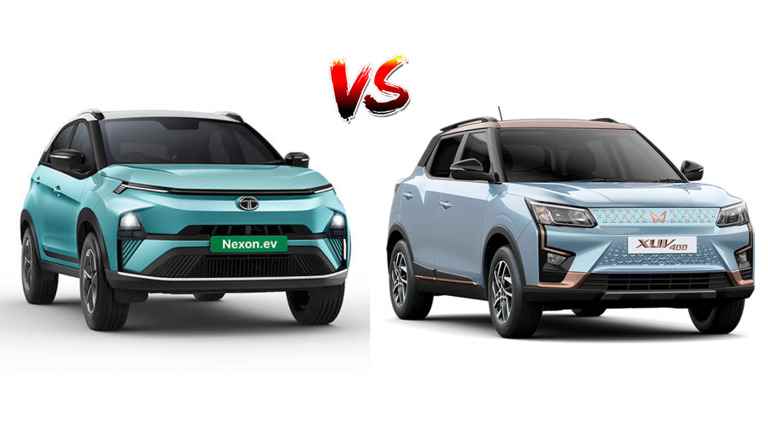In the rapidly evolving world of electric vehicles (EVs), Tata Motors and Mahindra & Mahindra are two prominent contenders aiming to electrify the Indian automotive landscape. With the Tata Nexon EV and the Mahindra XUV 400 Electric, both companies are vying for a leading position in the electric SUV market. In this comprehensive comparison, we will dive into the specifications, performance, features, and overall value of these two electric titans.
Introduction: Electrifying the Future of Indian Automobiles
The transition to electric vehicles represents a significant shift in the automotive industry, driven by environmental concerns and advancements in battery technology. Tata Motors and Mahindra & Mahindra, being stalwarts in the Indian automotive scene, have entered this arena with their respective electric SUVs.
Tata Nexon EV: The Pioneer
Design and Exterior
The Tata Nexon EV boasts a contemporary design with its signature humanity line grille and sharp LED headlights. Its aerodynamic silhouette not only enhances aesthetics but also contributes to its efficiency.
Performance and Range
Under the hood, the Nexon EV packs a 30.2 kWh lithium-ion battery paired with an electric motor. It offers a remarkable range of approximately 312 kilometers on a single charge. Its instant torque delivery ensures a swift 0-60 km/h acceleration in just 4.6 seconds.
Features and Interior
Inside the Nexon EV, you’ll find a spacious cabin with premium materials. The 7-inch touchscreen infotainment system supports Apple CarPlay and Android Auto, while safety features like ABS, EBD, and multiple airbags provide peace of mind.
Mahindra XUV 400 Electric: The Challenger
Design and Exterior
Mahindra’s XUV 400 Electric takes a more futuristic approach to design. With its illuminated grille and sculpted body lines, it aims to make a bold statement on the road.
Performance and Range
Powering the XUV 400 Electric is a 40 kWh battery pack paired with an electric motor. It offers a slightly higher range of around 350 kilometers and accelerates from 0 to 60 km/h in 4.8 seconds.
Features and Interior
The XUV 400 Electric features a plush interior with a larger touchscreen infotainment system at 10 inches. It also offers advanced driver-assistance systems like lane-keeping assist and adaptive cruise control.
Head-to-Head Comparison
Performance Battle
In terms of performance, both SUVs are evenly matched, providing impressive acceleration and a comfortable ride. The slight range advantage of the XUV 400 Electric may sway some buyers.
Charging Infrastructure
Tata Motors has invested significantly in expanding its charging infrastructure, giving Nexon EV owners peace of mind when it comes to charging their vehicles. Mahindra is also making strides in this area.
Price and Value
The Nexon EV is generally more affordable than the XUV 400 Electric, making it an attractive option for budget-conscious buyers. However, the XUV 400 Electric justifies its price with its additional features and larger battery.
Environmental Impact
Both EVs contribute positively to reducing carbon emissions, aligning with the global push for sustainable transportation.
Conclusion: Making the Right Choice
In the Tata Nexon EV vs. Mahindra XUV 400 Electric showdown, the choice ultimately depends on individual preferences and priorities. The Nexon EV offers a well-rounded package at a competitive price, while the XUV 400 Electric impresses with its futuristic design and advanced features.
Are you ready to embrace the electric revolution? Make your choice wisely and embark on a journey towards a greener future.
FAQs
Q. Are electric SUVs more expensive than their gasoline counterparts?
A. Electric SUVs tend to have a higher upfront cost due to battery technology. However, lower operating costs and government incentives can offset this initial expense.
Q. How do I find nearby charging stations for my electric SUV?
A. There are various smartphone apps and websites that provide real-time information on charging station locations, making it easy to plan your journeys.
Q. What is the maintenance cost of an electric SUV compared to a traditional one?
A. Electric SUVs generally have fewer moving parts, resulting in lower maintenance costs over time compared to traditional gasoline-powered SUVs.
Q. How long does it take to charge an electric SUV?
A. The charging time varies depending on the charger’s speed and the battery’s capacity. Fast chargers can provide a significant charge in around 30 minutes, while standard home chargers may take several hours.
Q. Are electric SUVs suitable for long road trips?
A. Yes, electric SUVs are suitable for long road trips, provided you plan your route with charging stations in mind. The growing charging infrastructure makes it increasingly feasible to travel long distances in electric vehicles.
